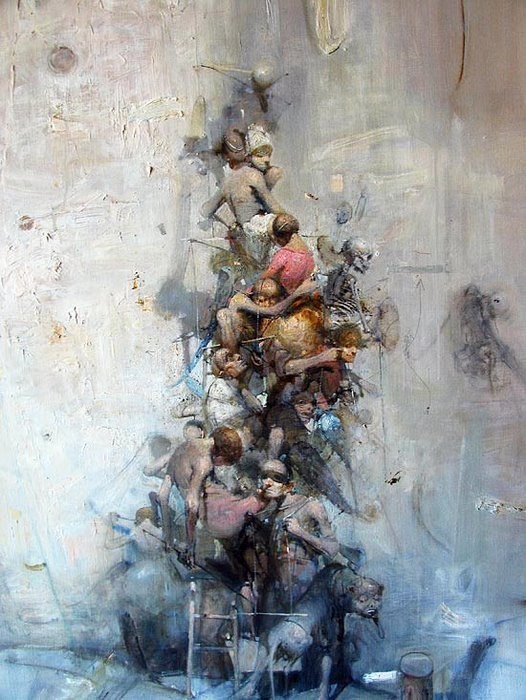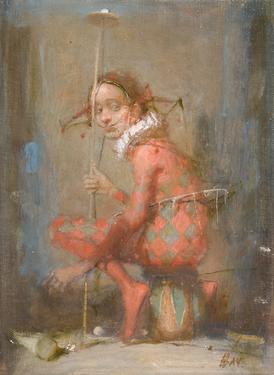
By Allison Rath –
When Norton Dodge (1927-2011) first traveled to the Soviet Union in 1955 to study the economic role of Russian women, he encountered the underground nonconformist art world in Moscow with the clandestine help of artist Valery Kuznetsov. Moved by the art he saw, Dodge would spend the next thirty years (1956-86) traveling back and forth from the United States to the Soviet Union under various pretenses, all the while smuggling Russia’s unofficial art back to America. Although by no means representative, Norton Dodge’s enterprising collecting was one of the first documented events of cultural diplomacy between individuals in America and Russia rather than the normal state-sponsored diplomatic channels where it would have been unlikely. Cultural diplomacy is never to be a replacement or surrogate for formal diplomacy but rather it can serve as an alternative whether or not state diplomacy succeeds or fails.
Sometimes this cultural diplomacy can be conducted under the auspices of global foundations, e.g., Rockefeller or or similar trusts. One of the premises underlying cultural diplomacy is that creative artists and their audiences should be able to communicate directly. State-sponsored diplomacy may not always best represent an artist, writer or musician in the same way that other artists, writers or musicians or their appreciative audiences might be able to understand and advocate for them. Cultural diplomacy can also be the undertaking of international entities like the United Nations for creative and intellectual exchange between sovereign states; the most substantial programs for formal cultural diplomacy in the United States can be found in the U. S. State Department’s Bureau of Educational or Cultural Affairs and the Fulbright Program is often considered the “flagship” of such academic endeavors.
Dodge, whose doctoral dissertation was in economics at Harvard and was later a professor of economics at University of Maryland, has been called the “Lorenzo de’ Medici of Russian Art” due to his connoisseurship patronage. [1] In total, beginning in the Khrushchev regime, Dodge ferried approximately 10,000 works of art from the USSR to the United States without state support in the Soviet era, eventually donating these works and 10,000 others to Rutgers University in the mid-1990s where they form a considerable part of the university collection at the Jane Voorhees Zimmerli Art Museum. [2] Dodge smuggled out works by artists such as Ely Bielutin (1925-2012), Victor Pivovarov (born 1937), and Vachagan Narazyan (born 1957), artists whose works remain powerful and relevant to this day.

When asked his motivation for taking such risks to bring Russian art out of the Soviet Union, Norton said, “I just am interested in getting it out and then people will have something to form their judgment on.”
This statement forms the basis for a viable argument regarding the merits of cultural diplomacy. While at times, official efforts at cultural diplomacy may have specific agendas, there is nothing so important and powerful as the basic exchange of cultural information. One of Norton’s friends, Allen MacDonald, would frequently leave copies of American magazines in the Moscow subway cars so that Russians could pick them up and take them home. He remarked of the Cold War climate, “With so much stifling of information and stifling of the human spirit, all of us felt a bond with the Russians and wanted to help the. We wanted to bring out the truth.”
Norton Dodge also appeared in an award-winning feature length documentary movie Vasya in 2002 about the Stalin-imprisoned legendary dissident Soviet artist Vasily Sitnikov (1915-87), one of whose paintings is the lead image here. As a Russian non-conformist Symbolist artist, Sitnikov was released from prison right before the end of Word War II and eventually emigrated to Austria in 1975 thanks in part to his fame and came to the U.S. in 1980, where he died on New York.

Vachagan Narazyan was born in 1957 in Kislovodsk, Russia and graduated from the Kharkiv Art Institute (now Ukraine) where he also taught from 1981-1993. Now prominent and represented across American galleries from coast to coast, especially known well in New York, Santa Fe and San Francisco, his initial non-conformist work would have been unlikely to have been viewed outside Russia except for Dodge’s advocacy and sharing it with the West. As a dissident artist, Narazyan rejected Soviet Conformist style and instead adopted a haunting and mysterious surrealism that often portrays enigmatic landscapes or circus themes with soft mythical realism reminiscent of his childhood rather than the official Soviet Realism emphasizing worker satisfaction.
Such efforts at sharing cultural truths like those of Norton Dodge should only serve to increase understanding, and with increased understanding of values, art, ideas, and trends should come a decrease in the likelihood of conflict based on misconceptions.
Today, the graffiti and new public art spaces on the remnant Berlin Wall stand as a reminder of the political power wielded by art and culture. Though the wall no longer divides East and West Berlin, this street art warns future Germans and foreign visitors alike of the once painful division between communism and capitalism that had the world’s superpowers vying for global influence. Here the dissident context itself is part of the message of the graffiti.
In 2011, while working for the Moscow Times, I had the fortune to interview Russian graffiti artists about their work, political aims, and experiences in the Moscow art scene. Learning about the Russian street art scene conveyed an astonishing amount about Russian politics and society. For millennia, graffiti has been found in urban contexts – such as at Pompeii before 79 AD/CE – and can often represent counter society or pop culture opposed to established culture, but it can also bluntly share the passionate or skeptical perceptions of the disenfranchised while also ranging across a broad political spectrum.
For example, while public vandalism in many European cities can easily result in jail-time, a run-in with the police will cost you at most a few hundred rubles or perhaps nothing at all “if the cop is in a decent mood and you are a good talker,” according to one Russian graffiti artist. Another artist, known as Pasha 183, or internationally as Russian Banksy, had commented that to him it was “most important is to represent the atmosphere in Moscow.”
Tragically, Pasha 183 died earlier this year of unknown causes, resulting in an international revival of his work on various media outlets. The work of Pasha 183 and his fellow artists needs to be better publicized in order to have an effect on the international understanding of Russian culture, but the potential is great.
Perhaps one of the most promising venues for cultural diplomacy lies in relations between the Arab and Western world. Daniel Barenboim’s East-West Divan Orchestra has successfully bridged and reduced some of the cultural, political and religious tensions between Palestinian and Israeli youth musicians, among others while performing Classical music together on tour; although some international components who may not wish success in peace or harmony could naturally oppose such efforts at cultural diplomacy . A current topic of discussion centers around the burqa bans enacted in France, Belgium, and the Netherlands, and the ban being debated in Britain. While many Westerners erroneously assume that every woman in a burqa must be the victim of brainwashing or restriction of agency, many Muslim women maintain that it is their right to wear the burqa as an important religious and cultural tradition. Of an annotated 354 women recently stopped in France for donning a burqa, every single one said that it was a fully personal decision.
The large fashion industry based around the burqa and the hijab stands as a testament to the burqa’s cultural importance. Those attempting to promote better understanding of Muslim culture should seek to propagate high-fashion imagery and convey the notion of burqa fashion as a form of art on par with widely accepted international fashion houses. A burqa debut at fashion week in Paris or Milan could well do more to calm the religious tension in Europe and America than scores of press conferences and diplomatic summits at reducing ignorance and suspicion. This could be especially true if posturing or pandering to please hardline domestic elements is removed, which could be a cultural breakthrough when undertaken by the fashion industry rather than political entities.
* Editor’s Note: Alli Rath has been invited to present at the upcoming Berlin Conference for the Institute for Cultural Diplomacy in mid-December.
Notes:
[1] John McPhee. The Ransom of Soviet Art. New York: Farrar, Straus and Giroux, 1994, 3-4, 96.
[2] Alla Rosenfeld and Norton Dodge, editors. From Gulag to Glasnost: Nonconformist Art from the Soviet Union. Thames and Hudson/The Jane Voorhees Zimmerli Art Museum, Rutgers, 1995.